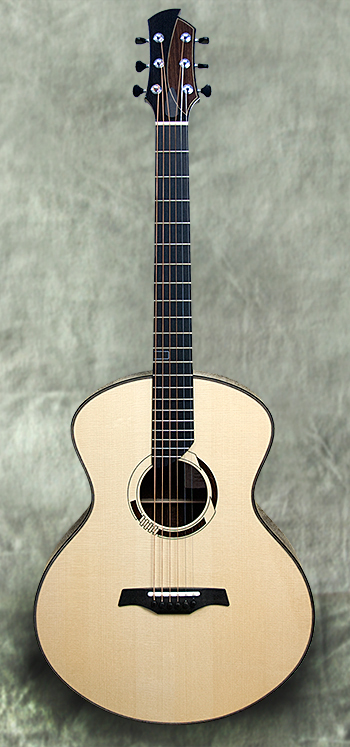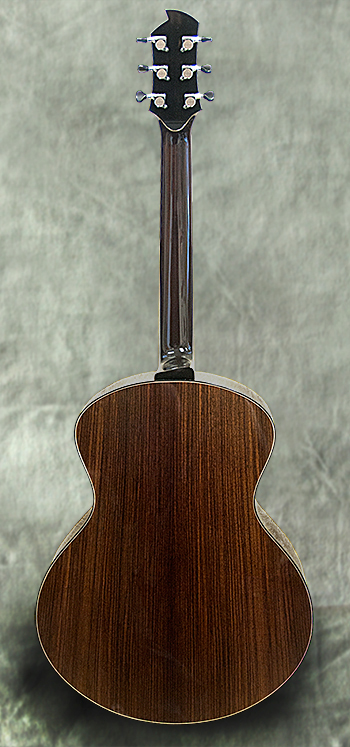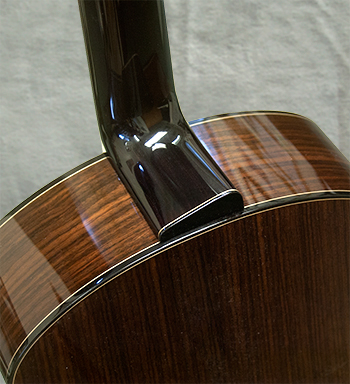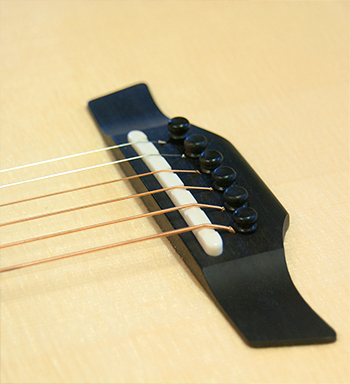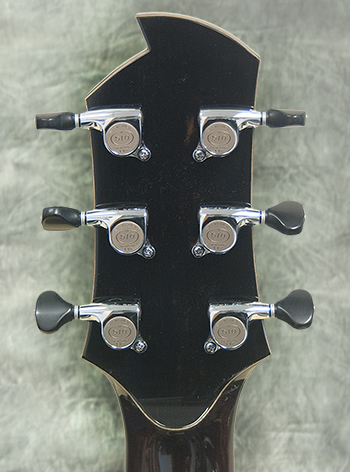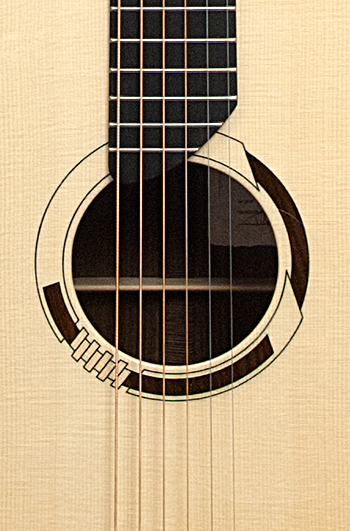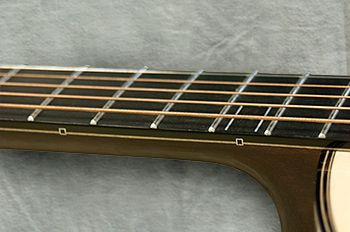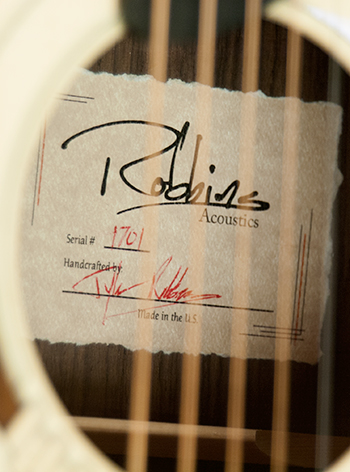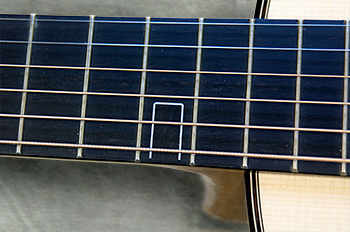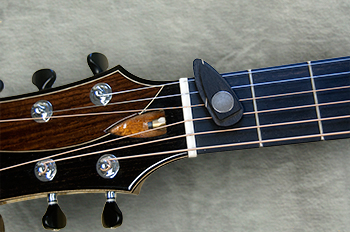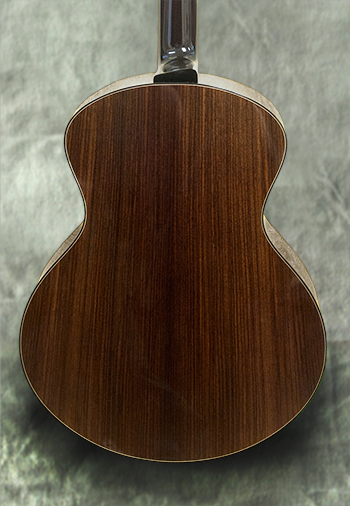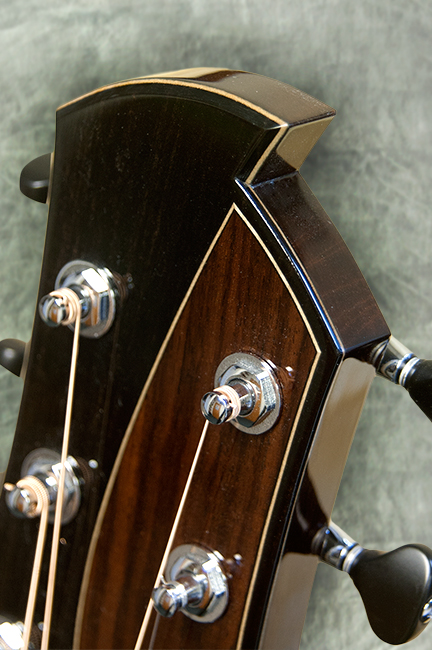2017 Robbins R.1
(click on images to see larger versions)
– Robbins R.1 guitar, ser. #1701
– body type: between OM & small jumbo in size
– top: Engelmann spruce
– back & sides: East Indian rosewood
– neck: Honduran mahogany w/ adj. truss rod, 13 frets to the body
– fingerboard: ebony
– bridge: ebony
– bridgepins: ebony
– front headplate: ebony & rosewood w/maple trim; maple underlayer
– body bindings: ebony w/ maple purfling on top, sides & back
– fingerboard binding: ebony w/ maple purfling
– heelcap: ebony w/ maple purfling
– nut: bone
– saddle: bone
– tuners: silver finish Gotoh 510s w/ black plastic buttons
– rosette: Robbins custom in rosewood & ebony
– side fret markers: aluminum squares
– 12th fret marker: aluminum 3-sided square
– pickguard: clear plastic
– neck profile: shallow ‘C’ to ‘U’ shape
– frets: #148 Medium nickel silver
– finish: nitrocellulose lacquer
– case: TKL American Vintage Series hardshell case
DIMENSIONS:
scale length: 25.5″
nut width: 1.75″
string spacing at saddle: 2.375″
weight: 4.5 lbs.
width, upper bout: 11.125″
width, lower bout: 15.875″
depth at neckblock: 3.75
depth at tailblock: 4.75
body length: 20″
total length: 40.5″
www.robbinsacoustics.com
razor279@aol.com
A Player’s Review, 8/5/18:
I was making one of my periodic visits to nearby Dream Guitars to see what was new in the shop. I had been intrigued by the review of the R.1 on their website and it was one of the reasons I made the trip. Among their usual plethora of stellar instruments the R.1 really stood out for me, and, as the first guitar from a talented new builder on the rise, I didn’t hesitate to snap it up. At this writing, I’ve now played six of Tyler’s guitars and can report that they ALL have the characteristic features that form the basis for the signature ‘Robbins Voice’ and are the strengths of this particular instrument. Tyler already seems to be able to reproduce his Voice consistently, no matter what woods are used, which I find to be a singularly impressive feat, especially in a new builder.
Playing an instrument is a complex sensory experience involving Sight, Sound and Touch, and here are my thoughts regarding each of these dimensions for this guitar.
SIGHT
The R.1’s design is clean and uncluttered, with a refreshingly original and integrated aesthetic in the decorative elements, embodied in Tyler’s signature headstock profile, matching truss rod cover (secured to the adjustment nut by a small magnet) and a rosette that varies a palette of simple geometric figures into patterns that are unique to each instrument. The other, more decorated Robbins guitars that I’ve seen retain an overall integration in their design motifs which tend toward the geometric. The Indian rosewood back and sides are very straight-grained and the mahogany neck is stained to match the dark red-brown of the body. The neck employs small inlaid aluminum squares as side position markers with a larger, three-sided aluminum rectangle inlaid into the ebony fingerboard on the 12th fret. The nut and saddle are bone, and the ebony bridge is also Tyler’s signature shape. The saddle is compensated and of the greater thickness currently popular among modern builders.
TOUCH
Most of this category addresses how it feels to play it, but there are some basic tactile impressions as well.
The distinctive shape of the R.1, with its wide lower bout, and somewhat smaller shoulders and waist allows a fairly large body to feel as comfortable as a smaller-bodied instrument. The neck profile is between a ‘C’ and a ‘U’ shape, with a bit more wood on the neck’s ‘shoulders’ than I am used to. Subsequent Robbins guitars I’ve played have all had a more typical ‘C’ shape profile. String spacing at the nut is also slightly wider than my usual but still comfortable. The guitar is moderate in weight with a balance point favoring the neck end slightly. The finish is nitrocellulose and the neck is a tad ‘grabby’ to the fretting hand while playing, but that should moderate with continued use as the finish loses a bit of gloss. The body join at the 13th fret is a seldom-found compromise to placing the bridge closer to a position more favorable to maximizing the sweetness of the tone while retaining easy access to the higher frets, and works quite well.
SOUND
Balance
This instrument is well-balanced, with good note separation. Single notes are strong just about anywhere on the fingerboard, and when strummed, it rings with a solid, unified voice.
Sustain
I measure sustain by using a stopwatch, hitting a firm strum, then leaning in close until the sound fades to silence. I do this 4 or 5 times, then average the times. I’m usually within a second each time. The R.1’s sustain is just about right for my tastes and similar to my other instruments at around 30 seconds.
Volume & Projection
This is a measure of the amplitude for both player (volume) and listener (projection). From the player’s perspective, the R.1 is quite loud, perhaps the loudest guitar I have owned and its projection is equally excellent.
Response
This quality describes both the energy required to move the strings – its ‘sensitivity’ – as well as the speed at which it responds to that energy. A fast response is said to ‘pop,’ while a slower response will ‘bloom’ after the initial attack. The R.1 has good sensitivity and responds best to moderate force on the attack. The speed tends to the quicker end of the spectrum with very good ‘pop.’
Depth
The depth of the sound is what gives it dimension and presence. I think of it as how far down in the body the sound seems to come from and how completely the sound chamber is pushing out sound. The R.1 has excellent depth that I expect will improve as continued playing opens it up a bit.
Presence
Presence describes how much space the sound seems to occupy between the instrument and the listener. If it radiates out in a cone from the sound source, how wide does that cone seem to be? Is it relatively narrow and directional, or wider and more enveloping? The R.1 has very good presence that is currently more forward-focused but I expect it might broaden some with continued playing.
Resonance
The character of the harmonic frequencies as an indicator of how completely an instrument seems to be vibrating is what many call resonance. However, I make a distinction for it here as a measure of fullness in the sound I can both hear AND feel. This guitar has good to very good resonance and vibrates quite well.
Overtones
Overtones are the harmonic frequencies complementing the fundamental tones. Some limit the definition to partials of the plucked strings, but I use it to encompass sympathetic vibrations in the unplucked strings as well. As luthier Alan Carruth puts it, “An acoustic guitar acts as a complex filter, reducing the output of some frequencies and enhancing others relative to the mix the plucked string produces. Every guitar is a bit different in this regard.” An instrument that generates a lot of overtones is said to be ‘complex’ or ‘sparkling,’ while one with fewer overtones is said to be ‘dry.’ These complementary frequencies add tonal color and give the sound personality. The R.1 emphasizes the fundamental with enough overtones to add a bit of character.
Timbre/Tone
If the sustain and overtones give the sound ‘personality,’ timbre describes the quality of that personality, combining the fundamentals, overtones and all other resonant frequencies generated by both the vibrating strings and the vibrating wood to create a particular instrument’s unique voice. It’s what makes a middle ‘C’ played on a clarinet sound different from a middle ‘C’ played on a trumpet. It is this ‘quality of personality’ I believe most folks refer to when they speak generally about an instrument’s ‘tone,’ and this is a subjective area where metaphor becomes the standard currency. The tone of this guitar is fresh, original and assertive; straightforward and brash rather than complex and layered. It holds nothing back and all of its character is right there in your ear.
SUMMARY
This guitar flexes considerable muscle when played. It’s big-voiced, clean and uncluttered. Its tone is distinctive and will stand out in a room full of other fine guitars. Robbins is a singular new voice in the world of fine acoustic guitars and will bear watching as Tyler continues to refine his craft and more superlative examples of his work become available.,

